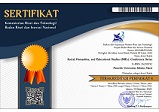The Impact of Mobile Banking on Personal Finance Management: A Study of Vocational Students at Universitas Sebelas Maret
Abstract
This study examines the factors influencing mobile banking adoption for personal financial management among vocational students at Universitas Sebelas Maret, focusing on perceived usefulness, ease of use, and social influence using the frameworks of TAM (Davis, 1989) and UTAUT (Venkatesh, 2003). As mobile banking becomes increasingly essential for digital financial services, understanding how young users adopt and utilize mobile banking is important. This study surveyed 142 vocational students at Universitas Sebelas Maret to assess their adoption of mobile banking for personal financial management. It examined their perceptions of mobile banking’s usefulness, ease of use, and social influence. Data were collected through structured questionnaires, and analyzed using regression techniques in Stata 19. The research also considered demographic factors such as gender, semester, and study program cluster to ensure the robustness of the findings. The results show that perceived usefulness and social influence significantly impact students’ financial planning behaviors, while perceived ease of use did not show a significant effect. These findings suggest that improving digital financial literacy and increasing awareness of mobile banking's benefits are key to enhancing students' personal financial management practices. Additionally, the banking industry needs to continue providing mobile banking services that are genuinely useful, so they can be adopted by students for better financial planning.
Penelitian ini meneliti faktor-faktor yang mempengaruhi adopsi mobile banking untuk manajemen keuangan pribadi di kalangan mahasiswa vokasi Universitas Sebelas Maret, dengan fokus pada persepsi manfaat, kemudahan penggunaan, dan pengaruh sosial menggunakan kerangka kerja TAM (Davis, 1989) dan UTAUT (Venkatesh, 2003). Seiring dengan semakin pentingnya mobile banking dalam layanan keuangan digital, pemahaman tentang bagaimana pengguna muda mengadopsi dan memanfaatkan mobile banking menjadi sangat penting. Penelitian ini mensurvei 142 mahasiswa vokasi Universitas Sebelas Maret untuk menilai adopsi mereka terhadap mobile banking untuk manajemen keuangan pribadi. Penelitian ini mengkaji persepsi mahasiswa terhadap manfaat mobile banking, kemudahan penggunaan, dan pengaruh sosial. Data dikumpulkan melalui kuesioner terstruktur dan dianalisis menggunakan teknik regresi di Stata 19. Penelitian ini juga mempertimbangkan faktor demografis seperti jenis kelamin, semester, dan rumpun program studi untuk memastikan kekuatan hasil penelitian. Hasil penelitian menunjukkan bahwa persepsi manfaat dan pengaruh sosial secara signifikan mempengaruhi perilaku perencanaan keuangan mahasiswa, sementara persepsi kemudahan penggunaan tidak menunjukkan pengaruh yang signifikan. Temuan ini menunjukkan bahwa meningkatkan literasi keuangan digital dan meningkatkan kesadaran akan manfaat mobile banking merupakan kunci untuk meningkatkan praktik manajemen keuangan pribadi mahasiswa. Selain itu, industri perbankan perlu terus menyediakan layanan mobile banking yang benar-benar bermanfaat, sehingga dapat diadopsi oleh mahasiswa untuk perencanaan keuangan yang lebih baik.
Keywords
Full Text:
PDFReferences
Agarwal, R., & Ann Elston, J. (2001). Bank-firm relationships, financing and firm performance in Germany. Economics Letters, 72(2), 225–232. https://doi.org/10.1016/S0165-1765(01)00427-X
Ajao, Q. M., Oludamilare, O., & Sadeeq, L. (2023). Drivers of Mobile Payment Acceptance: The Impact of Network Externalities in Nigeria. OALib, 10(06), 1–19. https://doi.org/10.4236/oalib.1110240
Alalwan, A. A., Dwivedi, Y. K., & Rana, N. P. (2017). Factors influencing adoption of mobile banking by Jordanian bank customers: Extending UTAUT2 with trust. International Journal of Information Management, 37(3), 99–110. https://doi.org/10.1016/j.ijinfomgt.2017.01.002
Baptista, G., & Oliveira, T. (2015). Understanding mobile banking: The unified theory of acceptance and use of technology combined with cultural moderators. Computers in Human Behavior, 50, 418–430. https://doi.org/10.1016/j.chb.2015.04.024
Damayanti, R. M., Utami, E. Y., & Pramesti, D. (2025). How parental education and financial savvy drive college students toward a green economy? IOP Conference Series: Earth and Environmental Science, 1438(1). https://doi.org/10.1088/1755-1315/1438/1/012063
Davis, F. D. (n.d.). Perceived Usefulness, Perceived Ease Of Use, And User Accep Perceived Usefulness, Perceived Ease of Use, and User Acceptance of Information Technology.
Davis, F. D. (1989). Perceived usefulness, perceived ease of use, and user acceptance of information technology. MIS Quarterly: Management Information Systems, 13(3), 319–339. https://doi.org/10.2307/249008
De, L. R., Financière, L. L., Malaisie, E. N., Sabri, M. F., & Macdonald, M. (2010). Savings Behavior and Financial Problems Among College Students: The Role of Financial Literacy in Malaysia COMPORTEMENT D’ÉPARGNE ET PROBLÈMES FINANCIERS CHEZ LES ÉTUDIANTS DE COLLÈGE. In Cross-cultural Communication (Vol. 6, Issue 3). www.cscanada.org
Gabor, D., & Brooks, S. (2017). The digital revolution in financial inclusion: international development in the fintech era. New Political Economy, 22(4), 423–436. https://doi.org/10.1080/13563467.2017.1259298
Kaplan, A. M., & Haenlein, M. (2010). Users of the world, unite! The challenges and opportunities of Social Media. Business Horizons, 53(1), 59–68. https://doi.org/10.1016/j.bushor.2009.09.003
Liu, J., Abhishek, V., Li, B., John Heinz, H., Fienberg, S. E., Geng, D., Kauffman, R. J., Li, Z.-O., Lin, M., Ma, D., Montgomery, A., Ondrus, J., & Tang, Q. (n.d.). THE IMPACT OF MOBILE CHANNEL ADOPTION ON CUSTOMER OMNI-CHANNEL BANKING BEHAVIOR.
Martins, C., Oliveira, T., & Popovič, A. (2014). Understanding the internet banking adoption: A unified theory of acceptance and use of technology and perceived risk application. International Journal of Information Management, 34(1), 1–13. https://doi.org/10.1016/j.ijinfomgt.2013.06.002
Neuman, W. Lawrence. (2014). Social research methods : qualitative and quantitative approaches. Pearson.
Suhartanto, D., Dean, D., Ismail, T. A. T., & Sundari, R. (2020). Mobile banking adoption in Islamic banks: Integrating TAM model and religiosity-intention model. Journal of Islamic Marketing, 11(6), 1405–1418. https://doi.org/10.1108/JIMA-05-2019-0096
Sutia, S., Fahlevi, M., Saparudin, M., Irma, D., & Maemunah, S. (2020). Should e-Payment Trust be e-Commerce Implemented as a Consumer Satisfaction Factor? E3S Web of Conferences, 202. https://doi.org/10.1051/e3sconf/202020216002
Tan, X., Xiao, J. J., Meng, K., & Xu, J. (2025). Financial education and budgeting behavior among college students: extending the theory of planned behavior. International Journal of Bank Marketing, 43(3), 506–521. https://doi.org/10.1108/IJBM-05-2024-0285
Venkatesh, V., Morris, M. G., Davis, G. B., & Davis, F. D. (2003). User acceptance of information technology: Toward a unified view. MIS Quarterly: Management Information Systems, 27(3), 425–478. https://doi.org/10.2307/30036540
Yeo, K. H. K., Lim, W. M., & Yii, K. J. (2024). Financial planning behaviour: a systematic literature review and new theory development. Journal of Financial Services Marketing, 29(3), 979–1001. https://doi.org/10.1057/s41264-023-00249-1
Refbacks
- There are currently no refbacks.





